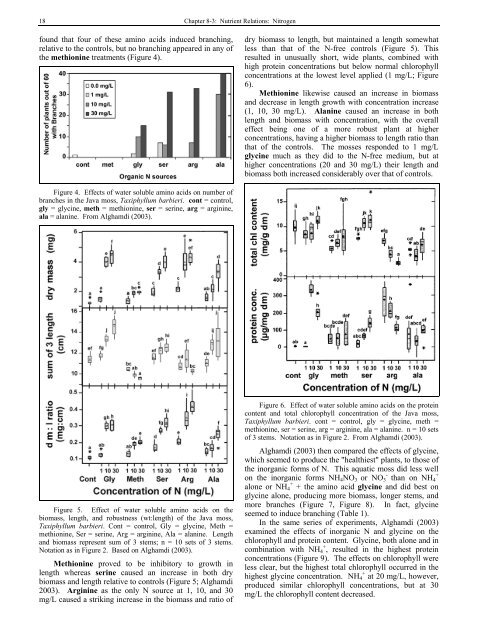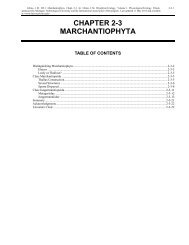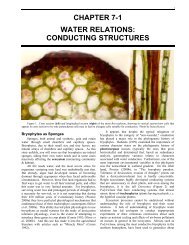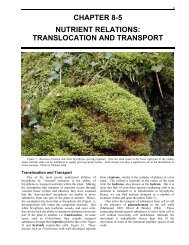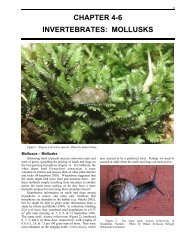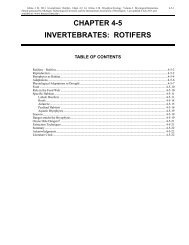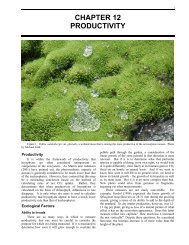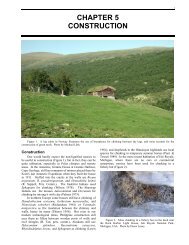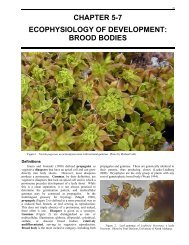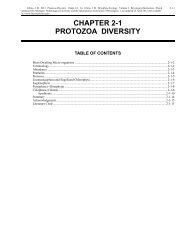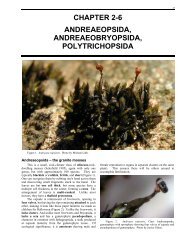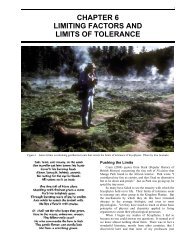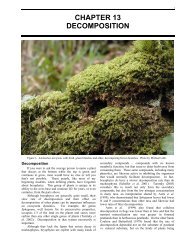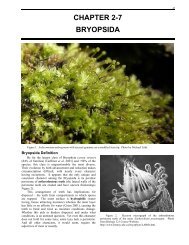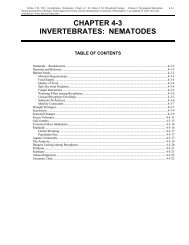chapter 8-3 nutrient relations: nitrogen - Bryophyte Ecology ...
chapter 8-3 nutrient relations: nitrogen - Bryophyte Ecology ...
chapter 8-3 nutrient relations: nitrogen - Bryophyte Ecology ...
Create successful ePaper yourself
Turn your PDF publications into a flip-book with our unique Google optimized e-Paper software.
18 Chapter 8-3: Nutrient Relations: Nitrogen<br />
found that four of these amino acids induced branching,<br />
relative to the controls, but no branching appeared in any of<br />
the methionine treatments (Figure 4).<br />
Figure 4. Effects of water soluble amino acids on number of<br />
branches in the Java moss, Taxiphyllum barbieri. cont = control,<br />
gly = glycine, meth = methionine, ser = serine, arg = arginine,<br />
ala = alanine. From Alghamdi (2003).<br />
Figure 5. Effect of water soluble amino acids on the<br />
biomass, length, and robustness (wt:length) of the Java moss,<br />
Taxiphyllum barbieri. Cont = control, Gly = glycine, Meth =<br />
methionine, Ser = serine, Arg = arginine, Ala = alanine. Length<br />
and biomass represent sum of 3 stems; n = 10 sets of 3 stems.<br />
Notation as in Figure 2. Based on Alghamdi (2003).<br />
Methionine proved to be inhibitory to growth in<br />
length whereas serine caused an increase in both dry<br />
biomass and length relative to controls (Figure 5; Alghamdi<br />
2003). Arginine as the only N source at 1, 10, and 30<br />
mg/L caused a striking increase in the biomass and ratio of<br />
dry biomass to length, but maintained a length somewhat<br />
less than that of the N-free controls (Figure 5). This<br />
resulted in unusually short, wide plants, combined with<br />
high protein concentrations but below normal chlorophyll<br />
concentrations at the lowest level applied (1 mg/L; Figure<br />
6).<br />
Methionine likewise caused an increase in biomass<br />
and decrease in length growth with concentration increase<br />
(1, 10, 30 mg/L). Alanine caused an increase in both<br />
length and biomass with concentration, with the overall<br />
effect being one of a more robust plant at higher<br />
concentrations, having a higher biomass to length ratio than<br />
that of the controls. The mosses responded to 1 mg/L<br />
glycine much as they did to the N-free medium, but at<br />
higher concentrations (20 and 30 mg/L) their length and<br />
biomass both increased considerably over that of controls.<br />
Figure 6. Effect of water soluble amino acids on the protein<br />
content and total chlorophyll concentration of the Java moss,<br />
Taxiphyllum barbieri. cont = control, gly = glycine, meth =<br />
methionine, ser = serine, arg = arginine, ala = alanine. n = 10 sets<br />
of 3 stems. Notation as in Figure 2. From Alghamdi (2003).<br />
Alghamdi (2003) then compared the effects of glycine,<br />
which seemed to produce the "healthiest" plants, to those of<br />
the inorganic forms of N. This aquatic moss did less well<br />
on the inorganic forms NH4NO3 or NO3 - than on NH4 +<br />
alone or NH4 + + the amino acid glycine and did best on<br />
glycine alone, producing more biomass, longer stems, and<br />
more branches (Figure 7, Figure 8). In fact, glycine<br />
seemed to induce branching (Table 1).<br />
In the same series of experiments, Alghamdi (2003)<br />
examined the effects of inorganic N and glycine on the<br />
chlorophyll and protein content. Glycine, both alone and in<br />
combination with NH4 + , resulted in the highest protein<br />
concentrations (Figure 9). The effects on chlorophyll were<br />
less clear, but the highest total chlorophyll occurred in the<br />
highest glycine concentration. NH4 + at 20 mg/L, however,<br />
produced similar chlorophyll concentrations, but at 30<br />
mg/L the chlorophyll content decreased.


